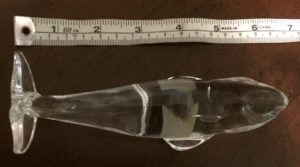In the early 1990’s, when I was an investigative reporter working for The News & Observer in Raleigh, I was given a glass whale about the size of a small banana in recognition of the work I had done.
Get it? I had done “a whale of a job.” It was only a trinket but it’s the thought that counts, right?

I figured my whale had come from one of those stores you see in every beach town, the kind that sells towels emblazoned with the Confederate battle flag, tiny bikinis, and t-shirts that say “Topsail Island.”
But when I showed it to my wife, Donna, she noticed a sticker on the bottom of the whale that said: “Baccarat.” My whale was crystal.
Later on I showed it to my mother-in-law, Nell Kiser Hyland, and told her about mistaking it for a trinket. I think she figured that whale was wasted on me, and she asked me to give it to her.

Nell, a really good woman with whom I never had a cross word, had never asked me for anything, so I wanted to give it to her. But I couldn’t. I had already promised our oldest son, Bo, that he could have it when I conked.
But Nell wouldn’t let that idea go and, finally, I said, OK, you can borrow the whale, and keep it until you die. And then I want it back.
She put that whale in her purse right then and there and took it home with her.
Several years passed and I became an editor. One morning, before I came to my senses and went back to reporting, I was in a meeting with other editors who were trying to figure out how to motivate reporters. Someone mentioned the whale-of-a-job whales and asked: How much did those whales cost? I sat up straight, mentally speaking, because that’s something I wanted to know myself. And when I heard the answer I almost fell out of my chair.
And then, believe it or not, I forgot. Oh, cut me some slack. Who remembers every little thing that happened decades ago.
A few days ago I decided to write about the whale and I emailed Frank Daniels III, who was executive editor of The N&O from 1990 to 1996, and asked him how much the paper had paid for the whale-of-a-job whales.
“I paid for them, not the company,” Frank III replied. “Back then they cost $195 each if I recall correctly, which I thought was too expensive to charge the company.”
I got mine in 1991 or ’92, so how much do you think my whale cost, adjusted for inflation?
At least $350.
And why am I writing about this now? Nell, who was 97 years old, died last week and the whale, on loan for more than 25 years, has come back home.
NOTE: Frank III also told me, “I gave myself one after I left the newsroom to remind me of what we accomplished, sits on my bookshelf still.”
Coming Monday: Baptists By Chance

